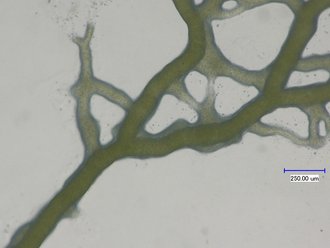
Schleimige Computer: Künstlerisch-wissenschaftliche Studie zu Schleimpilz-Forschung wird in hochrangigem internationalen Journal veröffentlicht
Der Computer der Zukunft könnte um einiges schleimiger sein als die Silizium-Geräte, mit denen wir es heutzutage zu tun haben. Genau damit befasst sich die Studie, die Theresa Schubert (Bauhaus-Universität Weimar, Professur Gestaltung medialer Umgebungen) und Andrew Adamatzky (University of the West of England, Bristol) in dem renommierten Journal »Materials Today« veröffentlicht haben.
Das Forschungsteam beschäftigt sich mit logischen Elementen, die durch lebende Schleimpilz-Organismen gebildet werden. Diese Formationen können als intelligente Bausteine für Computer und Sensoren eingesetzt werden, indem sie Informationen verarbeiten.
Der vollständige Artikel ist auf folgender Seite abrufbar: http://www.sciencedirect.com/science/article/pii/S136970211400025X
Die University of the West of England in Bristol gab dazu folgende Pressemitteilung heraus:
One is more likely to find the slime mold Physarum polycephalum living somewhere dark and damp rather than in a computer science lab. In its "plasmodium" or vegetative state, the organism spans its environment with a network of tubes that absorb nutrients. The tubes also allow the organism to respond to light and changing environmental conditions that trigger the release of reproductive spores.
In earlier work, the team demonstrated that such a tube network could absorb and transport different colored dyes. They then fed it edible nutrients - oat flakes - to attract tube growth and common salt to repel them, so that they could grow a network with a particular structure. They then demonstrated how this system could mix two dyes to make a third color as an "output".
Using the dyes with magnetic nanoparticles and tiny fluorescent beads, allowed them to use the slime mold network as a biological "lab-on-a-chip" device. This represents a new way to build microfluidic devices for processing environmental or medical samples on the very small scale for testing and diagnostics, the work suggests. The extension to a much larger network of slime mold tubes could process nanoparticles and carry out sophisticated Boolean logic operations of the kind used by computer circuitry. The team has so far demonstrated that a slime mold network can carry out XOR or NOR Boolean operations. Chaining together arrays of such logic gates might allow a slime mold computer to carry out binary operations for computation.
"The slime mold based gates are non-electronic, simple and inexpensive, and several gates can be realized simultaneously at the sites where protoplasmic tubes merge," conclude Adamatzky and Schubert.
Are we be entering the age of the biological computer? Stewart Bland, Editor of Materials Today, believes that "although more traditional electronic materials are here to stay, research such as this is helping to push and blur the boundaries of materials science, computer science and biology, and represents an exciting prospect for the future."
The research was undertaken in a framework of EU FP7 Project "Physarum Chip" (Unconventional Computing program).
# # #
Notes for Editors
This article is "Slime mold microfluidic logical gates" by Andrew Adamatzky and Theresa Schubert. It appears in Materials Today, Volume 17, Issue 2, March 2014, Pages 86–91 (2014) published by Elsevier. The article is available for free at www.materialstoday.com
About Materials Today
Materials Today is a community dedicated to the creation and sharing of materials science knowledge and experience. Supported by Elsevier, we publish high impact peer-reviewed journals, organize academic conferences, broadcast educational webinars and so much more.
The Materials Today journal is an Open Access journal, specializing in topical reviews, and covering the latest research, news, comment, and opinion in materials science.
Für Fragen wenden Sie sich gern an Theresa Schubert, wissenschaftliche Mitarbeiterin an der Professur Gestaltung medialer Umgebungen unter +49 (0) 36 43/58 38 99 oder per Mail an theresa.schubert-minski@uni-weimar.de.
Kontakt
Bauhaus-Universität Weimar
Claudia Weinreich
Pressesprecherin
Tel.: +49(0)3643/58 11 73
Luise Ziegler
Mitarbeiterin Medienarbeit
Tel.: +49(0)3643/58 11 80
Fax: +49(0)3643/58 11 72
E-Mail: presse[at]uni-weimar.de
Web: www.uni-weimar.de/medienservice
